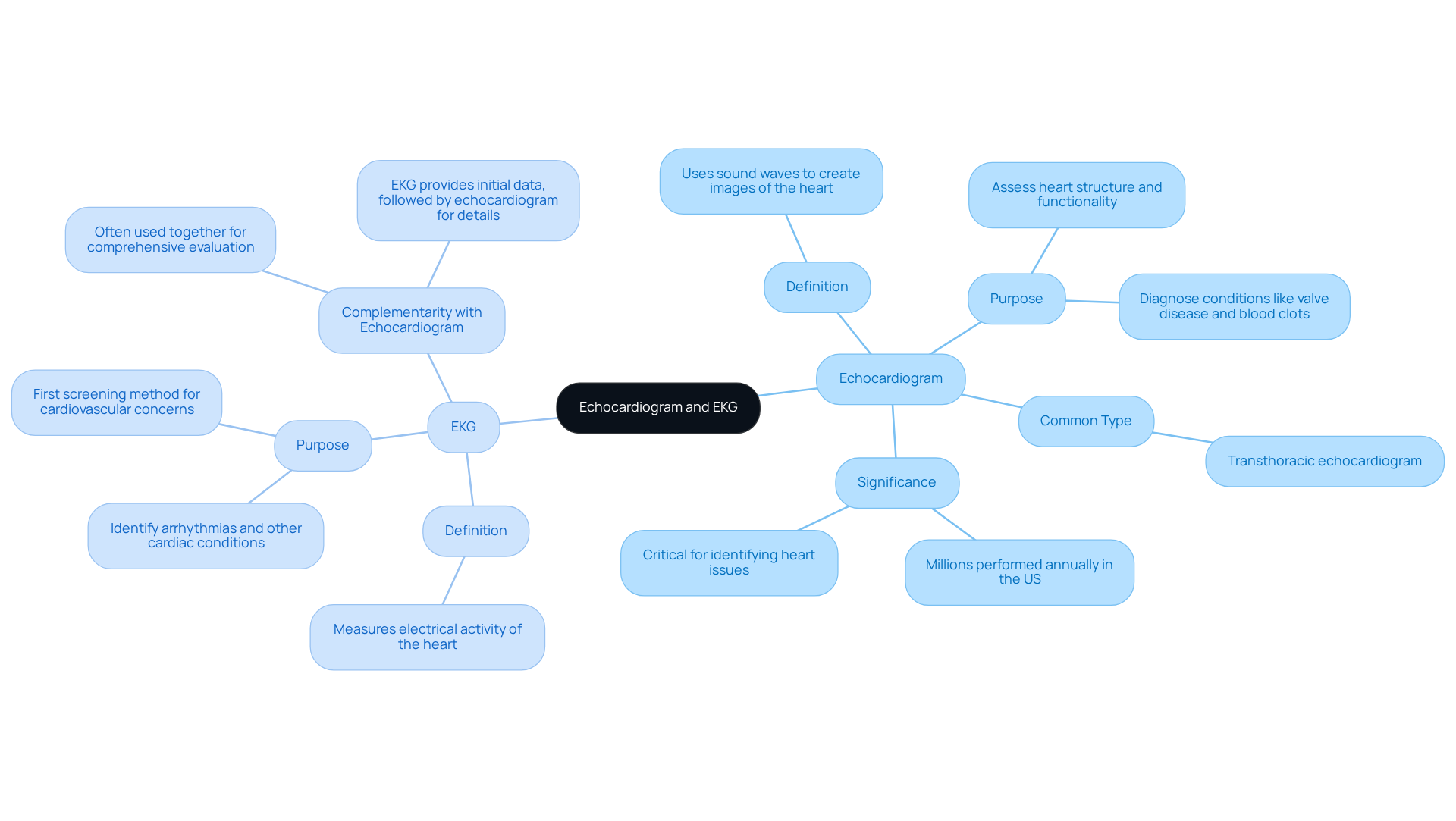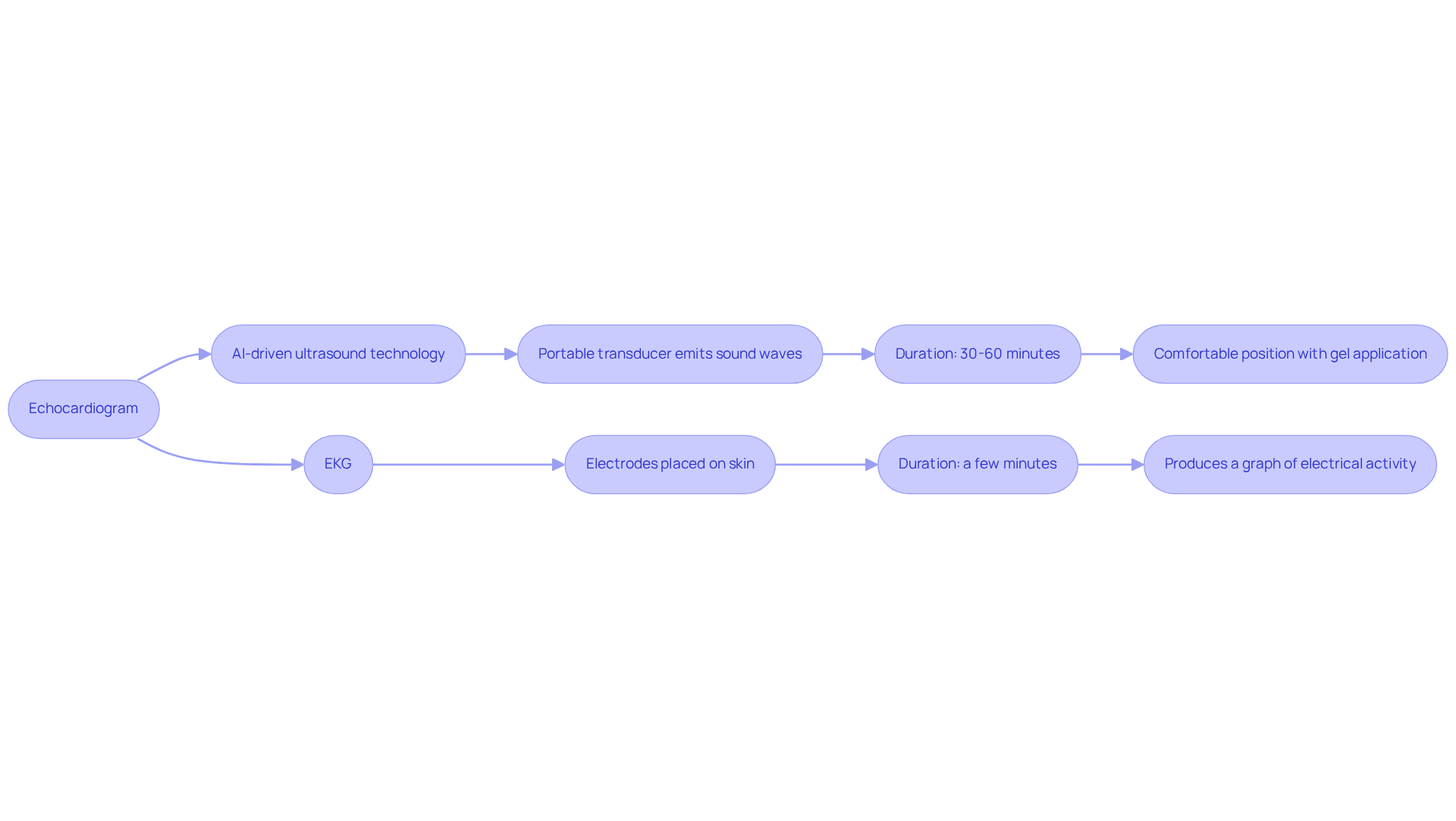


Understanding heart health can feel overwhelming, especially when it comes to the tests used for diagnosis. Two commonly used tests, the echocardiogram and the electrocardiogram (EKG), play distinct yet complementary roles in assessing cardiovascular conditions. Both are non-invasive and essential for identifying heart issues, but they differ significantly in their functions and the information they provide.
How can you navigate the complexities of these tests to ensure your heart health is in good hands? This article explores the key differences between echocardiograms and EKGs, shedding light on their unique contributions to cardiac care and decision-making.
In addition to this, understanding these tests can empower you to take charge of your health. Remember, you’re not alone in this journey; we’re here to support you every step of the way.
An ultrasound scan, often called an 'echo,' is a gentle, non-invasive procedure that uses sound waves to create dynamic images of your heart. The most common type of echocardiogram is the transthoracic echocardiogram, which allows healthcare providers to assess the heart's structure and functionality. This includes examining the size and shape of the heart, the condition of the valves, and the blood flow within it.
In contrast, an electrocardiogram (EKG or ECG) measures the heart's electrical activity, capturing its rhythm and identifying potential issues such as arrhythmias and other cardiac conditions. Both examinations are noninvasive and typically take less than an hour to complete. While both assessments are crucial for identifying heart issues, they serve different purposes: ultrasound scans provide detailed visuals of the heart's structure and operation, while EKGs focus on the electrical signals that control heartbeats.
In the United States, millions of heart ultrasound tests are performed each year, underscoring their significance in cardiac care. If you're experiencing symptoms like difficulty breathing, which may indicate valve disease, or an irregular heartbeat, your doctor might recommend an ultrasound examination. Heart valve problems can lead to breathlessness and fatigue, but at Amavita, Dr. Martinez-Clark specializes in minimally invasive valve treatments that can significantly improve these symptoms. Remember, if left untreated, valve disease can progress to heart failure.
Recent research suggests that these two examinations complement each other well. EKGs often serve as the first screening method for cardiovascular concerns, followed by ultrasound imaging for more comprehensive evaluations. As Kristin Shaffer, PA-C, notes, 'Many people wonder if an echocardiogram is the same as EKG, as both are examinations available to identify problems with your cardiovascular system.' Furthermore, Roman Gokhman emphasizes that 'both an EKG and an echocardiogram, which is echocardiogram same as EKG, are considered noninvasive procedures that take less than an hour.'
If you have any concerns about your heart health, don’t hesitate to reach out for support. Your well-being is our priority, and we’re here to help you every step of the way.

Echocardiograms are vital tools for visualizing the heart's structure and assessing its pumping efficiency, especially within Amavita's CardioElite™ program, which focuses on comprehensive cardiovascular care. These tests play a crucial role in diagnosing conditions like valve disease, which affects many older adults, and cardiomyopathy, a serious condition that can lead to heart failure. Did you know that around 12% of older individuals are diagnosed with valve disease? This statistic highlights just how important echocardiograms are for this age group.
The CardioElite™ program takes patient management a step further by integrating advanced imaging capabilities. This means more precise evaluations and better monitoring of treatments, which can make a real difference in your care. In contrast, EKGs focus on the heart's electrical activity, providing insights into its rhythm and rate. They are particularly effective in identifying arrhythmias and other electrical issues. For instance, studies show that EKGs can detect arrhythmias in older adults, leading to timely interventions that significantly improve outcomes.
A cardiology specialist once shared, 'EKGs are essential for early detection of arrhythmias, especially in older adults, where timely treatment can prevent serious complications.' While echocardiograms provide a comprehensive view of the heart's anatomy and function, it is echocardiogram same as EKG in that EKGs provide a snapshot of its electrical health. Together, these tests form essential components of thorough cardiac care, ensuring that you receive the most accurate diagnoses and effective treatments.
Moreover, the integration of AI technology within Amavita's CardioElite™ program enhances echocardiographic assessments, allowing for even more precise evaluations and improved patient outcomes. Remember, taking care of your heart is a journey, and we're here to support you every step of the way.

Echocardiograms use advanced, AI-driven ultrasound technology to create real-time images of your heart. A portable transducer emits sound waves that bounce off cardiac structures, allowing healthcare professionals to see your heart in action. This innovative approach is FDA-cleared and AHA certified, typically taking just 30 to 60 minutes in a hospital or outpatient setting. You’ll lie comfortably on your left side, with gel applied to your chest to help the sound waves travel smoothly.
What’s truly remarkable is that the AI algorithms ensure precise imaging and can generate reports on your heart's structure and function within minutes. This means early detection of potential issues, empowering you to make informed choices about your cardiac health.
In contrast, an EKG is a quicker procedure, often completed in just a few minutes. It involves placing small electrodes on your skin-usually on your chest, arms, and legs-to detect the electrical impulses generated by your heart. This information is then sent to a machine that produces a graph of your heart's electrical activity, making it a convenient option for initial assessments.
At Amavita Heart and Vascular Health®, we’re dedicated to improving health outcomes and reducing hospital readmissions, especially for those in skilled nursing facilities. Recent research shows that many individuals feel more comfortable during ultrasound examinations compared to EKGs, likely due to the non-invasive nature of the ultrasound process.
Echocardiograms have also advanced with techniques like 3D echocardiography, which offers more detailed images and enhances diagnostic accuracy. While both examinations are vital for assessing cardiovascular health, many patients wonder, is echocardiogram same as EKG, and the choice between them often depends on your specific needs and circumstances. Remember, we’re here to support you every step of the way, ensuring you feel valued and cared for.

At Amavita Heart and Vascular Health, we understand that concerns about heart health can be overwhelming, especially for those at high risk. That's why we emphasize focused cardiovascular care, using tools like echocardiograms and EKGs, while explaining that an important question is whether an echocardiogram is the same as EKG, to support our patients every step of the way.
Echocardiograms play a vital role in identifying structural abnormalities in the heart. These tests can reveal issues that may require surgical interventions, such as valve repair or replacement. A study involving 1.2 million individuals shows just how important echocardiograms are in assessing the severity of cardiac failure, helping us tailor treatment approaches effectively.
In addition to this, EKGs are essential for diagnosing acute conditions like myocardial infarctions and arrhythmias, which often require immediate medical attention. Dr. Eric Elgin emphasizes that EKGs help us identify high-risk individuals who could benefit from more intensive treatments before their condition worsens.
Together, these tests help clarify whether an echocardiogram is the same as an EKG for a comprehensive evaluation of your heart health. This synergy allows our healthcare providers at Amavita to create personalized treatment plans that address both structural and electrical heart issues. We believe that this integration is crucial for optimizing patient care and improving overall outcomes, especially in emergency situations where timely decisions can make a significant difference in survival.
If you have any concerns about your heart health, please don’t hesitate to reach out. We’re here to support you and ensure you receive the care you deserve.

Understanding the differences between an echocardiogram and an EKG is essential for anyone who cares about their heart health. Both are non-invasive procedures that play significant roles in cardiovascular care, yet they serve different purposes. An echocardiogram offers detailed images of the heart's structure and function, while an EKG focuses on the electrical activity that regulates heartbeats. Recognizing these differences empowers you to take a more active role in managing your heart health.
Throughout this article, we’ve shared key insights about the functions and technological aspects of both tests. Echocardiograms are invaluable for diagnosing structural heart issues, especially in older adults, while EKGs are crucial for detecting arrhythmias and other electrical abnormalities. The integration of advanced technology, including AI, enhances the effectiveness of echocardiograms, making them even more vital in clinical settings. Together, these tests provide comprehensive evaluations, facilitating timely and effective treatment decisions.
Ultimately, understanding the roles of echocardiograms and EKGs can lead to better patient outcomes and more informed healthcare choices. We encourage you to consult your healthcare provider about any heart health concerns you may have and to consider these diagnostic tools as part of a proactive approach to cardiovascular wellness. Taking action today can pave the way for a healthier tomorrow, reinforcing the importance of regular heart health assessments. Remember, you are not alone on this journey; support is always available.
What is an echocardiogram?
An echocardiogram, often referred to as an 'echo,' is a non-invasive ultrasound scan that uses sound waves to create dynamic images of the heart, allowing healthcare providers to assess its structure and functionality.
What does an echocardiogram examine?
An echocardiogram examines the size and shape of the heart, the condition of the valves, and the blood flow within the heart.
What is an EKG (electrocardiogram)?
An EKG, or ECG, measures the heart's electrical activity, capturing its rhythm and identifying potential issues such as arrhythmias and other cardiac conditions.
How do echocardiograms and EKGs differ?
Echocardiograms provide detailed visuals of the heart's structure and operation, while EKGs focus on the electrical signals that control heartbeats.
How long do echocardiograms and EKGs typically take?
Both echocardiograms and EKGs are non-invasive procedures that typically take less than an hour to complete.
Why might a doctor recommend an echocardiogram?
A doctor might recommend an echocardiogram if a patient is experiencing symptoms like difficulty breathing, which may indicate valve disease, or an irregular heartbeat.
What are the potential consequences of untreated valve disease?
Untreated valve disease can progress to heart failure, leading to serious health complications.
How do echocardiograms and EKGs complement each other in cardiac care?
EKGs often serve as the first screening method for cardiovascular concerns, followed by echocardiogram imaging for more comprehensive evaluations.
Who can assist with heart health concerns?
Healthcare professionals, such as Dr. Martinez-Clark at Amavita, can provide support and specialized treatments for heart health concerns.